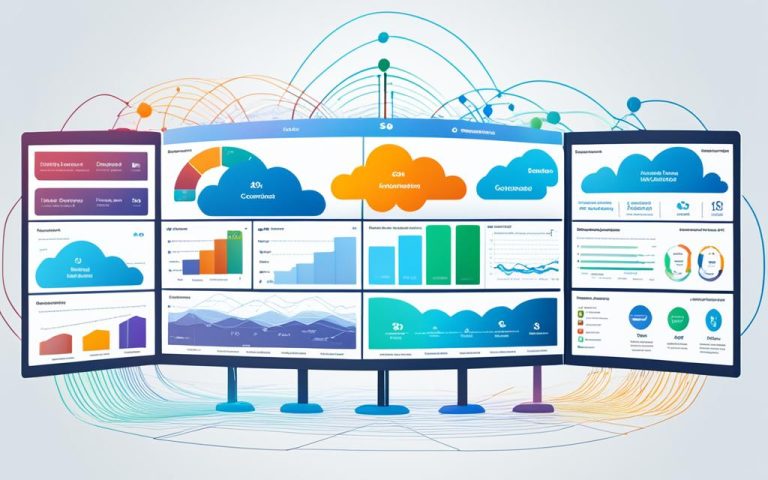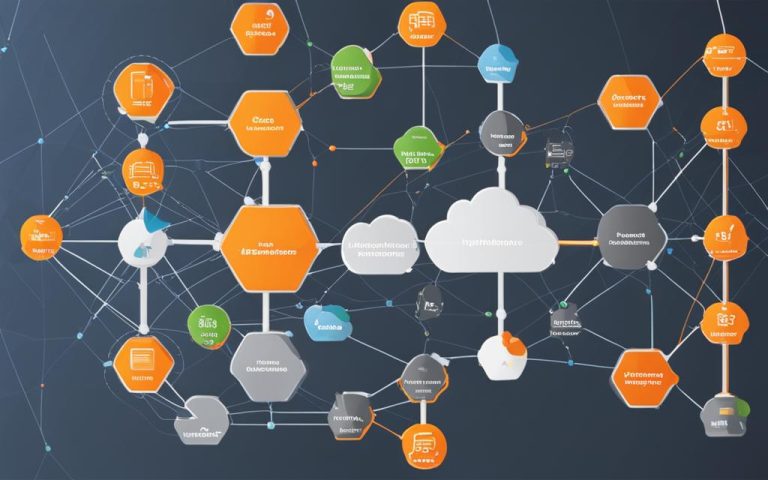Cloud management platforms are essential for organizations to monitor, manage, and control their cloud environments. These platforms offer a range of features such as unified management dashboards, policy management, performance monitoring, reporting and analytics, governance and security capabilities, metering and billing, automation and orchestration, and configuration for cloud storage and network resources. In this article, we will compare the top 7 cloud network management platforms based on their key offerings, ease of integration, and user experience.
When it comes to comprehensive cloud platforms comparison, it is important to consider the cloud management capabilities provided by each platform. By evaluating the features and functionalities offered, organizations can make informed decisions about which platform best suits their needs.
The top 7 Cloud Management Platforms we will be exploring include:
The Benefits of Cloud Management Platforms
Cloud management platforms offer several benefits to organizations. They help save time by automating manual tasks and freeing up resources for innovation. These platforms also contribute to cost savings by managing cloud resources efficiently, identifying idle resources, optimizing workloads, and choosing cost-effective compute resources.
Additionally, they provide visibility into cloud usage and costs, allowing organizations to track anomalies, understand cost centers, forecast, and budget. Cloud management platforms also enable faster innovation by eliminating cloud waste and freeing up resources for new features.
Cloud management platforms are essential for organizations to effectively manage their cloud environments. By leveraging these platforms, organizations can streamline their operations, enhance efficiency, and drive business growth. With the ability to save time, achieve cost savings, gain visibility, and foster faster innovation, cloud management platforms are becoming increasingly crucial in today’s digital landscape.
Let’s take a closer look at the benefits:
- Time Savings: Cloud management platforms automate manual tasks, reducing the time spent on administrative processes. This allows organizations to focus their resources on more strategic initiatives and innovation, driving business growth.
- Cost Savings: These platforms optimize cloud resource allocation, identify idle resources, and recommend cost-effective compute resources. By effectively managing cloud resources, organizations can achieve substantial cost savings.
- Visibility: Cloud management platforms provide real-time insights into cloud usage and costs. This visibility helps organizations track anomalies, understand cost centers, forecast future expenses, and allocate budgets effectively.
- Faster Innovation: By eliminating cloud waste and optimizing resource allocation, cloud management platforms free up resources that can be allocated to developing new features and driving innovation.
With the numerous benefits they offer, it’s no wonder that organizations are increasingly turning to cloud management platforms to enhance their cloud operations and drive business success.
Meta-description:
Discover the benefits of cloud management platforms, including time savings, cost savings, increased visibility, and faster innovation. Learn how these platforms revolutionize cloud operations and drive business growth.
Top Cloud Management Platforms of 2024
In this section, we will explore the top cloud management platforms of 2024. These platforms offer a range of features and functionalities to help organizations effectively manage their cloud environments. The top platforms include:
| Platform | Description |
|---|---|
| nOps | An AI-powered FinOps automation platform that helps reduce costs. |
| IBM Cloud Orchestrator | Provides end-to-end service deployment and monitoring. |
| Apache CloudStack | A versatile open-source cloud computing platform. |
| Apptio Cloudability | A cloud financial management platform. |
| Morpheus Data | A cloud management and orchestration platform. |
| CloudHealth by VMware | A comprehensive cloud management platform. |
| Terraform | An open-source infrastructure-as-code tool. |
Each platform has its unique strengths and offerings, catering to different management needs. These top cloud management platforms provide organizations with the necessary tools and capabilities to streamline their cloud operations and drive efficiency.

When choosing a cloud management platform, it is important to consider factors such as scalability, security, integration capabilities, and user experience. By selecting the right platform, organizations can effectively manage their cloud environments and optimize their cloud operations.
Cloud Management Software Features and Considerations
When it comes to managing cloud infrastructure, organizations need powerful tools that can streamline processes and optimize performance. Cloud management software offers a wide range of features to meet these needs. Here are some key features to consider when choosing a cloud management software solution:
- Scalability: The ability to scale resources up or down based on demand is crucial for ensuring efficient resource allocation and cost optimization.
- Security and Compliance Management: Robust security and compliance capabilities help organizations safeguard their data and ensure adherence to industry regulations.
- Performance Monitoring and Optimization: Real-time monitoring and performance optimization features enable organizations to identify and address performance issues promptly.
- Root Cause Analysis: The ability to identify the root causes of issues quickly and efficiently is essential for minimizing downtime and optimizing resource allocation.
- Integration Capabilities: Seamless integration with other systems and tools allows for efficient data exchange and streamlines workflows.
- Cross-Platform Compatibility: Compatibility with different cloud platforms ensures flexibility and the ability to manage multi-cloud or hybrid cloud environments.
- User-Friendly Interface: Intuitive and user-friendly interfaces simplify the management process and reduce the learning curve for administrators.
- Automation and Orchestration Capabilities: Automation and orchestration features enable organizations to streamline processes and reduce manual interventions.
- Customer Support: Responsive and effective customer support is crucial for resolving issues promptly and ensuring smooth operations.
- Pricing: Consideration of the software’s pricing structure and cost-effectiveness is key to staying within budget and maximizing the value of the investment.
Organizations should carefully evaluate these features based on their specific needs and requirements. Choosing the right cloud management software can empower organizations to effectively control their cloud infrastructure and optimize performance, security, and cost management.
“Cloud management software offers a wide range of features to help organizations manage their cloud infrastructure effectively”
The Role of Cloud Cost Intelligence
Cloud cost intelligence plays a crucial role in optimizing cloud costs and maximizing the value of cloud resources. By effectively managing and optimizing cloud costs, organizations can achieve significant cost savings and improve their overall cloud management strategy. Two key tools that help organizations in this endeavor are CloudZero and ProsperOps.
CloudZero: CloudZero is a cloud cost intelligence platform that provides detailed cost metrics and actionable insights. It enables organizations to understand the cost of supporting specific features, track resource consumption, and allocate costs effectively. With CloudZero, organizations can gain complete visibility into their cloud spending and make data-driven decisions to optimize costs.
ProsperOps: ProsperOps offers a solution to optimize AWS Reserved Instances and automates the use of Spot Instances. By leveraging machine learning and automation, ProsperOps helps organizations maximize cost savings by intelligently managing their cloud resources. It continuously analyzes usage patterns and recommends optimal strategies for resource allocation, ensuring cost-optimized cloud deployments.
Furthermore, Kubernetes cost optimization is vital for organizations utilizing Kubernetes to manage their containerized applications. By employing Kubernetes cost optimization strategies, such as right-sizing and workload consolidation, organizations can minimize unnecessary costs and optimize resource allocation in their Kubernetes environments.
By leveraging these cloud cost intelligence tools and adopting effective cost optimization practices, organizations can make informed decisions, control cloud spending, and achieve long-term cost savings while maintaining high-performance cloud environments.
Stay tuned for the next section, where we will explore other cloud management platforms and tools that can further enhance your cloud management capabilities.
Other Cloud Management Platforms and Tools
In addition to the top cloud management platforms mentioned earlier, there are several other platforms and tools available for cloud management. These platforms offer a range of features and functionalities to help organizations effectively manage their cloud environments.
OpenStack
One notable cloud management tool is OpenStack, an open-source cloud computing infrastructure software project. OpenStack helps organizations manage compute, storage, and networking resources efficiently. It provides a scalable and flexible solution for building and managing private and public cloud environments.
CloudBolt
Another popular cloud management platform is CloudBolt. It enables enterprise IT departments to build, deploy, and manage private and public clouds. CloudBolt offers hybrid cloud management capabilities, allowing organizations to optimize their cloud resources and streamline operations.
Both OpenStack and CloudBolt are powerful cloud management tools that provide organizations with the necessary capabilities to effectively manage their cloud infrastructure.
| Cloud Management Platform | Key Features |
|---|---|
| OpenStack |
|
| CloudBolt |
|
Conclusion
In conclusion, when it comes to effectively managing cloud environments, organizations must make informed decisions by comparing and choosing the right cloud network management platform. By thoroughly evaluating the key offerings, ease of integration, and user experience of different platforms, organizations can develop a robust cloud management strategy.
Cloud management platforms offer a wide range of benefits, including time and cost savings, increased visibility, and accelerated innovation. With automation and optimization features, these platforms help save valuable time by streamlining manual tasks, allowing organizations to focus on innovation and growth. Moreover, by optimizing cloud resources and identifying cost-effective options, cloud management platforms enable significant cost savings.
Visibility plays a crucial role in effective cloud management. Cloud management platforms provide organizations with valuable insights into cloud usage and costs, allowing them to track anomalies, allocate costs effectively, and make data-driven decisions. Additionally, these platforms foster faster innovation by freeing up resources, eliminating cloud waste, and enabling organizations to deploy new features promptly.
When choosing a cloud network management platform, it is essential for organizations to carefully evaluate their specific needs and requirements. By aligning the platform’s capabilities with their goals and objectives, organizations can ensure a seamless cloud management experience, make informed decisions, and optimize their cloud resources effectively.
FAQ
What are cloud management platforms?
Cloud management platforms are software solutions that organizations use to monitor, manage, and control their cloud environments. These platforms offer various features such as unified management dashboards, policy management, performance monitoring, and more.
What are the benefits of using cloud management platforms?
Cloud management platforms offer several benefits, including saving time by automating manual tasks, cost savings by efficiently managing cloud resources, visibility into cloud usage and costs, and enabling faster innovation by eliminating cloud waste.
Which are the top cloud management platforms of 2024?
The top cloud management platforms of 2024 include nOps, IBM Cloud Orchestrator, Apache CloudStack, Apptio Cloudability, Morpheus Data, CloudHealth by VMware, and Terraform. Each platform has its unique strengths and offerings.
What are the key features to consider when choosing cloud management software?
When choosing cloud management software, it is important to consider features like scalability, security and compliance management, performance monitoring and optimization, integration capabilities, automation and orchestration capabilities, and customer support.
What is the role of cloud cost intelligence?
Cloud cost intelligence plays a crucial role in optimizing cloud costs and maximizing the value of cloud resources. Tools like CloudZero and ProsperOps provide detailed cost metrics and actionable insights to help organizations understand costs and allocate them effectively.
Are there other cloud management platforms and tools available?
Yes, apart from the top cloud management platforms mentioned earlier, there are other tools like OpenStack and CloudBolt available for cloud management. These platforms offer a range of features and functionalities to help organizations effectively manage their cloud environments.




















One Comment